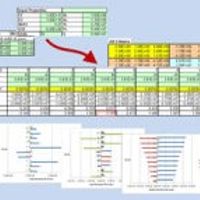NAFEMS E-Learning courses run several times per year at various time-slots, in order to make the syllabus as accessible as possible to all attendees wherever they are located.
Browse our complete list of courses below for details, and if the course you are interested in has not been scheduled to run at the moment, you can place yourself on the wait list and we'll let you know as soon as the next run has been confirmed.
If you would like to be notified about future offerings of one or more of our eLearning courses, please complete the form below and indicate which courses are of interest to you. Note : The NAFEMS E-Learning Wait List form is only to notify you when a future course of interest becomes available (i.e. you are not registering for a course by completing the information below). First Name

Understand, implement, and get the most out of explicit dynamic simulation methods. Specialised design problems involving short-duration high-pressure loadings generally require the use of explicit dynamics methods to obtain a good answer within reasonable time scales. These problems generally simulate severe loading and material failure, from events such as impact, blast loading, car crash, etc

Why does a PSD plot have such strange units? Why are dynamic effects important in shock spectra? Why does non-linear stiffness dissipate energy? Get the answers to these questions and more with this industry-leading, code-independent e-learning course on: This course covers a broad range of solution types, beyond the usual natural frequency and dynamic response methods. This allows more

New to FEA and concerned about how to use it in the real world? This course gives you practical advice with a minimum of theory. The six-session course offers excellent guidance on how to assess and plan the task of carrying out structural analysis using FEA. Finite Element Analysis is a powerful, widely used and universally accepted technique. However, for those new to FEA there is a steep

This course has now been retired, and it's contents incorporated into the expanded "Introduction to Practical CFD" course. Do you need a more accurate approach to include fluid loads or thermal boundary conditions for structural analyses than idealized and simplified approaches? Do you know the important fluid dynamics phenomena in multidisciplinary problems? What is the role of CFD in strongly

Time to take a closer look at Composites FEA? Need a clear path through analysis setup and interpretation? This industry-leading, code-independent e-learning course gives you the background for effective FEA. This 5-session, live online course will cover a range of topics, all aimed at structural designers and engineers. Composite systems include many more factors than conventional metallic

What are the challenges faced in 3-D turbulent flow simulations? What are practical approaches to simulate turbulent flows? There are many turbulence models. What are the bases for these models? What are the advantages and limitations of each model? How do I select a turbulence model for my applications? Get the answers to these questions and more with this industry-leading, code-independent

What are the technologies used in fatigue analysis and fracture mechanics – how do the approaches differ? What is the difference between high-cycle and low-cycle fatigue? What approach should I use in assessing fatigue and damage tolerance? The prediction of fatigue is a requirement for most products. However, the application of fatigue analysis is not easy and a good background is essential to

New to Multibody Dynamics Simulation and concerned about how to use it in the real world? How can I avoid classic mistakes and move quickly to actual models running smoothly? How can I get an overview of existing Multibody Dynamics Simulation codes? Get the answers to these questions and more with this industry-leading, code-independent e-learning course. This 3-session, live online course

Do you know if your model is realistic? What is the importance of normal modes analysis? How do you calculate transient and frequency response input parameters effectively? Get the answers to these questions and more with this industry-leading, code-independent e-learning course. This 6-session, live online course will cover a range of topics, all aimed at structural designers and engineers

Unlock the Full Potential of Modelling and Simulation in your Organisation The technological advances of recent years have led to a massive increase in product complexity. Businesses need to make sure they can engineer and deliver efficient and optimised products to not only lead but also remain competitive. Maximising the opportunities and benefits gained from the latest digital engineering

What are the differences between various differencing and meshing schemes? What are the basics of turbulence, heat transfer, and FSI modelling? What are errors and uncertainties in CFD and how do you reduce them? Get the answers to these questions and more with this industry-leading, code-independent e-learning course. New Revised Course for 2025 This course offers attendees fundamental

How is plastic behaviour in metals simulated and used in practical engineering applications? What are potential difficulties and challenges in modelling plasticity problems using FE software? What are the potential errors and limitations of the FE plasticity solutions? This course gives you practical advice with a minimum of theory. The course covers plasticity theories that are widely used to

How is creep behaviour in metals simulated and used in practical engineering applications? What are the potential difficulties and challenges in modelling creep problems using FE software? What are the potential errors and limitations of the FE creep solutions? This course gives you practical advice with a minimum of theory. This eLearning course is aimed at engineers and designers who want

How are residual stresses caused by welding in metals simulated and used in practical engineering applications? What are the difficulties and challenges of using FE software to simulate welding? What are the potential errors and limitations of the FE solutions in predicting residual stresses caused by welding? This course gives you practical advice with a minimum of theory. This e-learning course

How can I create advanced MBD models ? How can I simulate nonlinear effects using MBD technology ? How can I include more realism in my MBD models ? Get the answers to these questions and more with this industry-leading, code-independent e-learning course. This 3-session course offers guidance on how to assess and plan the task of carrying out advanced Multibody Simulation Analysis of systems and

What are the most important nonlinear FEA analysis topics? What practical hints and tips do I need to be able to carry out nonlinear analysis effectively? What theoretical background do I need to understand the implications of my nonlinear analysis? Get the answers to these questions and more with this industry-leading, code-independent e-learning course. This 6-session, live, online course

Most structures involve some form of jointing or connection. Traditional fabricated structures have used many thousands of bolts and rivets to connect components together in a continuous manner, in the case of ships and aircraft the total can run into millions. Even today many structures rely on this type of technology – for example, the use of spot welds in a modern road vehicle. Significant

This course is your starting point towards really understanding solid mechanics. You need to understand the basics to enable you to apply good practice in your finite element analysis, and this course will give you the knowledge you really need for a good understanding of the principles that every engineer or designer should know. You don't need in-depth knowledge about FEA or computational

Course Overview Finite Element Analysis has emerged has a tool that can play a vital part in the drive towards the ultimate goal of any manufacturing process ; to produce the most effective products in the most efficient manner. This simple statement embraces all of the ‘right first time’, ‘minimum design to test cycles’ and other practices that have evolved. The introduction of a formal

This course aims to provide an understanding of the calculations required to determine the internal forces and stress distributions that correspond to the external loads applied on different structures utilised for their efficiency under certain conditions. The course deals with beams that support bending forces acting along their length, shells and cylinders that support normal forces acting on

What are complex and cyber-physical systems? How do I numerically evaluate their behaviour? How can I efficiently model a complex system? Get the theory and the practical know-how to enable you to develop and improve your complex system numerical modelling activities. The course is an excellent opportunity to learn the fundamentals and practicalities of the critical aspects of systems modelling:

What are Electromagnetic fields? How can we mathematically describe them in a clear and understandable way? How can we compute Electromagnetic fields and critically assess the results? What are boundary and initial conditions, and how do we set them prior to our simulation? How can we effectively and accurately perform Electromagnetic simulation? What are the best-practice simulation tips and

How do I model a lubricated contact in a simulation setting? What is the correct combination of numerical methods for different regimes of lubrication? How do I consider realistic system level data as well as experimental inputs to achieve practical results? Learn how to realistically and practically simulate lubricated contacts with this e-learning course from NAFEMS. Low Load Hydrodynamic and

How do I help others see what I see? How can I simplify this for others? How can I make this more memorable for the people I am talking to? Get the answers to these questions and more with this transformative course. Using techniques and materials which have been adopted by many of the major companies in the engineering analysis and simulation industry, this course will supercharge your

Why do polymers have rate-dependent behavior? How can you capture this behavior with modern test methods? What models are available in FE codes, and how can I find the parameters for my test data? Advanced and accurate modeling of time- and temperature-dependent response of thermoplastics, elastomers, TPEs, composites, and foams. Modern solid mechanics FE codes have built-in, advanced

Are you struggling with convergence issues before obtaining results in your more complex models? Are you looking for a methodological approach to speed up the debugging of advanced models and increase the efficiency of your discussions with your favorite support hotline? Are you new to FEA and want to learn how to speed up the debugging of your models that haven’t worked on your first try? A

How can Python automate and streamline FEA workflows? What techniques allow for batch analysis and iterative optimization using Python in FEA? How does integrating Python enhance the efficiency and accuracy of Finite Element Analyses? A comprehensive guide to using Python for automation and iterative optimization in FEA Unlock the full potential of your Finite Element Analysis (FEA) projects by
For groups of 20 or more we can offer any of our e-learning courses on an exclusive basis adding even more convenience and flexibility to our program of e-learning.
All NAFEMS e-Learning courses are accredited by NAFEMS and led by leading figures in the worldwide engineering analysis community. All courses will provide live instructor-led sessions to allow attendees an opportunity to interact with the course instructor.















